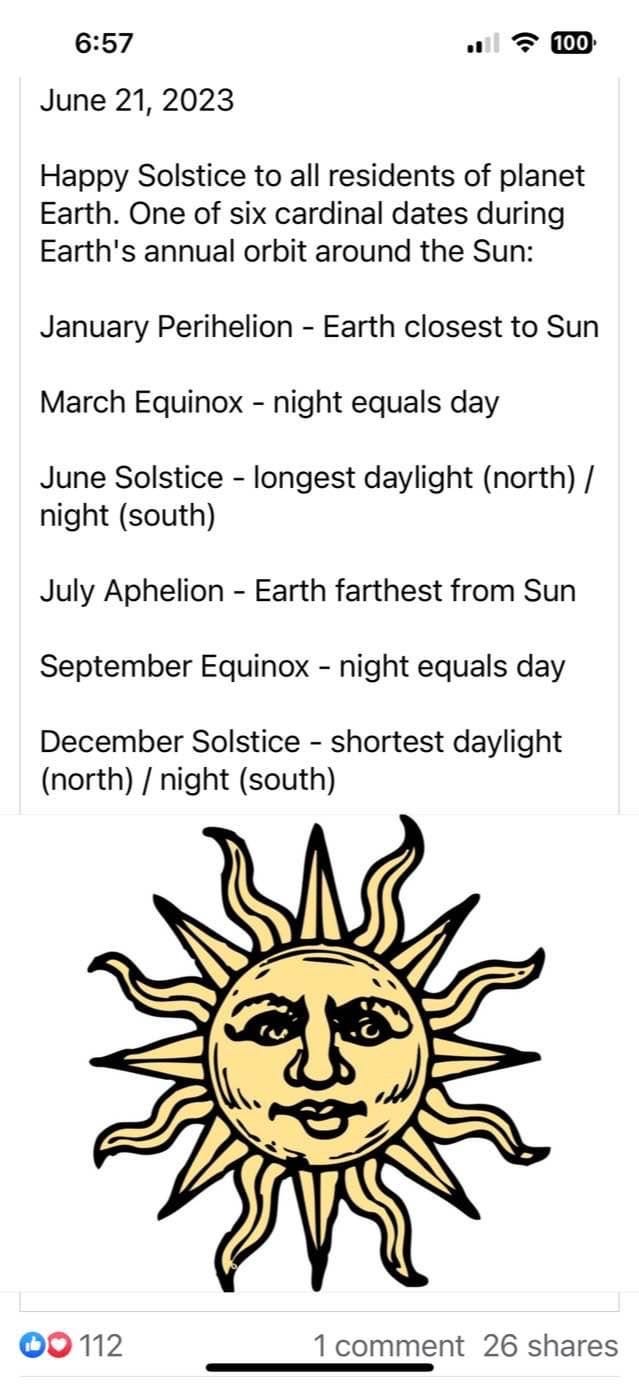Issue #347: Friday Funday June 23, 2023
The solstices and equinoxes are astronomical events that occur twice a year and mark important points in the Earth's orbit around the sun. They have been observed and celebrated by different cultures throughout history, and continue to be important today. The singular forms of these words are "solstice" and "equinox."
First, let's define what these events are. The solstices occur twice a year, around June 21st and December 21st, and mark the longest and shortest days of the year, respectively. These dates are also known as the summer and winter solstices. The equinoxes occur around March 20th and September 22nd, and mark the two days of the year when day and night are roughly equal in length. These dates are also known as the spring and fall equinoxes. The exact dates of each vary by a day or two annually.
sol·stice: noun
the time or date (twice each year) at which the sun reaches its maximum or minimum declination, marked by the longest and shortest days (about June 21 and December 22).
ORIGIN
Middle English: from Old French, from Latin solstitium, from sol ‘sun’ + stit- ‘stopped, stationary’ (from the verb sister).
e·qui·nox: noun
the time or date (twice each year) at which the sun crosses the celestial equator when day and night are of approximately equal length (about September 22 and March 20).
ORIGIN
late Middle English: from Old French equinoxe or Latin aequinoctium, from aequi- ‘equal’ + nox, noct- ‘night’.
One of the main differences between the solstices and equinoxes is the length of the day and night. During the solstices, one hemisphere of the Earth is tilted towards the sun, resulting in longer days and shorter nights, while the other hemisphere experiences shorter days and longer nights. During the equinoxes, both hemispheres receive roughly equal amounts of sunlight, resulting in equal lengths of day and night.
Despite these differences, both events have been important to cultures around the world for thousands of years. The ancient Egyptians, for example, built the Great Sphinx so that it points directly towards the rising sun on the day of the spring equinox. This was likely a way to mark the beginning of a new year and celebrate the return of spring.
Please make sure to view and act on the important information at the end of this article to help support “We Are Speaking.” Thank you!
In ancient Rome, the winter solstice was celebrated with the festival of Saturnalia, which honored the god Saturn and included feasting, gift-giving, and other festivities. Similarly, the ancient Incas of South America celebrated the winter solstice with a festival called Inti Raymi, which honored the sun god Inti and included offerings of food and drink, as well as music and dancing.
Today, the solstices and equinoxes continue to be celebrated in many parts of the world. In the United States, for example, the summer solstice is celebrated with the annual Stonehenge Solstice Festival in New York, which features live music, food, and other activities. In Mexico, the spring equinox is celebrated at the ancient Mayan ruins of Chichen Itza, where thousands of people gather to witness the alignment of the sun with the temple of Kukulcan.
Another interesting fact about the solstices and equinoxes is their relationship to the seasons. The solstices mark the beginning of summer and winter, while the equinoxes mark the beginning of spring and fall. This is because the Earth's tilt on its axis causes different parts of the planet to receive different amounts of sunlight throughout the year, resulting in the four seasons we experience.
In addition to their cultural and seasonal significance, the solstices and equinoxes also each have an important astronomical significance. For example, during the winter solstice, the Earth is at its closest point to the sun in its orbit, while during the summer solstice, it is at its farthest point. Similarly, during the equinoxes, the Earth's tilt is perpendicular to the sun's rays, resulting in equal amounts of sunlight in both hemispheres.
The solstices and equinoxes are important astronomical events that have been observed and celebrated by cultures around the world for thousands of years. While they have some differences in terms of day length and seasonal significance, they are both important markers in the Earth's orbit around the sun. Whether you celebrate them with music, dance, or simply by spending time outdoors, these events are a reminder of our connection to the natural world and the cycles of life that we all share.
Let us know your thoughts about what new information you learned in the comments or in the Substack Notes feature.
You can always leave any questions in the comments or email us.
This article is free to access for 7 days after publication. Please consider becoming a paid subscriber for $5/month or less to access all of the articles and other benefits.
This is your chance to support everything Keith and Pam do. We appreciate you!
Purchase and download your copy of the “Branding And Marketing For The Rest Of Us” eBook for Independent Authors and Creative and Solo Professionals and other valuable eBooks.
Enroll in one of the 6-course bundles designed especially for you: “Author and Book Marketing” and/or “Essential Creative Marketing.”
Purchase your copies of “Detroit Stories Quarterly” issues.
What else do Keith and Pam do?
Where else can you find us?
Click the link below to learn everything you need to know and review everything we offer for independent writers and creative and solo professionals.








